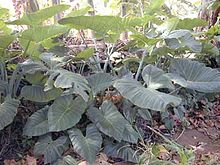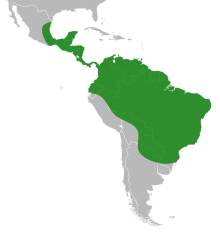
The Araceae are a family of monocotyledonous flowering plants in which flowers are borne on a type of inflorescence called a spadix. The spadix is usually accompanied by, and sometimes partially enclosed in, a spathe. Also known as the arum family, members are often colloquially known as aroids. This family of 140 genera and about 4,075 known species is most diverse in the New World tropics, although also distributed in the Old World tropics and northern temperate regions.

Dieffenbachia, commonly known as dumb caneorleopard lily, is a genus of tropical flowering plants in the family Araceae. It is native to the New World Tropics from Mexico and the West Indies south to Argentina. Some species are widely cultivated as ornamental plants, especially as houseplants, and have become naturalized on a few tropical islands.
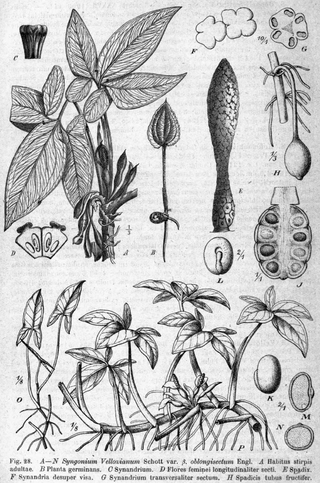
Syngonium is a genus of flowering plants in the family Araceae, native to tropical rainforests in southern Mexico, the West Indies, Central and South America. They are woody vines growing to heights of 10–20 m or more in trees. They have leaves that change shape according to the plant's stage of growth, and adult leaf forms are often much more lobed than the juvenile forms usually seen on small house plants. The scientific name of the genus comes from the Greek words σύν and γονή and refers to the fused ovaries of female flowers.

Philodendron is a large genus of flowering plants in the family Araceae. As of September 2015, the World Checklist of Selected Plant Families accepted 489 species; other sources accept different numbers. Regardless of number of species, the genus is the second-largest member of the family Araceae, after genus Anthurium. Taxonomically, the genus Philodendron is still poorly known, with many undescribed species. Many are grown as ornamental and indoor plants. The name derives from the Greek words philo- 'love, affection' and dendron 'tree'. The generic name, Philodendron, is often used as the English name.
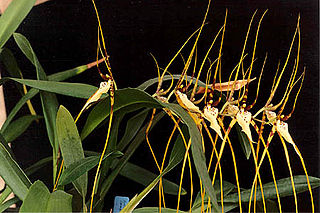
Brassia is a genus of orchids classified in the subtribe Oncidiinae. It is native to Mexico, Central America, the West Indies, and northern South America, with one species extending into Florida.
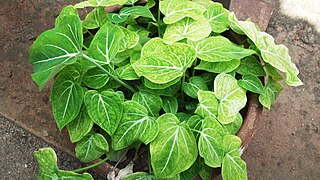
Caladium is a genus of flowering plants in the family Araceae. They are often known by the common name elephant ear, heart of Jesus, and angel wings. There are over 1000 named cultivars of Caladium bicolor from the original South American plant.

Pouteria is a genus of flowering trees in the gutta-percha family, Sapotaceae. The genus is widespread throughout the tropical Americas, with outlier species in Cameroon and Malesia. It includes the canistel, the mamey sapote, and the lucuma. Commonly, this genus is known as pouteria trees, or in some cases, eggfruits.

Dracontium is a genus of flowering plants similar to those of Amorphophallus. Unlike Amorphophallus which is found in the Old World, this genus has a New World distribution and is native to South America, Central America, southern Mexico, and the West Indies.

Pitcairnia is a genus of plants in the family Bromeliaceae, subfamily Pitcairnioideae. It was named for William Pitcairn, Scottish physician and gardener (1711–1791). The genus Pitcairnia ranks as the second most prolific of the bromeliad family. They are most abundant in Colombia, Peru and Brazil, but can also be found in areas from Cuba and Mexico south to Argentina. One species, Pitcairnia feliciana, is found in tropical West Africa and is the only member of the family Bromeliaceae not native to the Americas.

Heteropsis is a genus of plants in the family Araceae, native to Central and South America.

Rhodospatha is a genus of plant in family Araceae. It is native to South America, Central America, and southern Mexico.
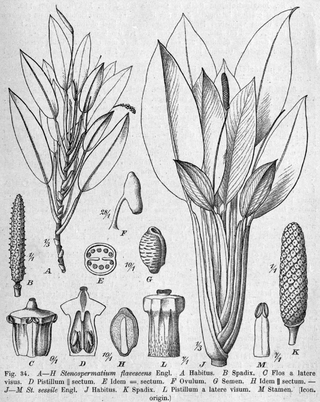
Stenospermation is a genus of plant in family Araceae native to South America and Central America.
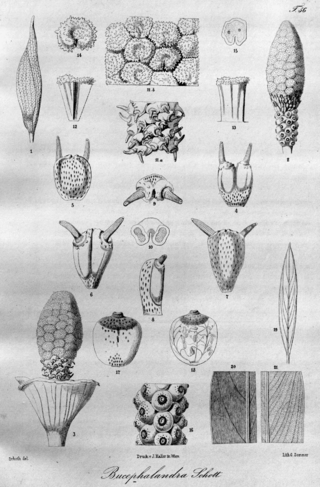
Bucephalandra is a genus of flowering plants in the family Araceae. There are 30 species of Bucephalandra which have been discovered in Borneo and have been formally described by S.Y. Wong and P.C. Boyce. Most of the species are found in Borneo. Bucephalandra are usually found growing as dense mats over stones or rocks in streams or rivers in moist tropical forest.

Aroideae is a subfamily of flowering plants in the family Araceae. It is the largest subfamily in Araceae and consists of about 72 different genera, and 2,300 species. Many Aroideae have spiny pollen grains without a sporopollenin outer exine layer and lacking an aperture.

Urospatha is a genus of flowering plants in the family Araceae that consists of 11 known species. They are found growing in South America and Central America in swamps, wet savannahs, and brackish water. The leaves of the species in this genus are upward pointing and sagittate (arrow-shaped). The inflorescences are quite unique; the spathe is mottled and elongated with a spiral twist at the end. The seeds are distributed by water and have a texture similar to cork that allows them to float. They also quickly germinate in water.

Montrichardia is a genus of flowering plants in the family Araceae. It contains two species, Montrichardia arborescens and Montrichardia linifera, and one extinct species Montrichardia aquatica. The genus is helophytic and distributed in tropical America. The extinct species M. aquatica is known from fossils found in a Neotropical rainforest environment preserved in the Paleocene Cerrejón Formation of Colombia. Living Montrichardia species have a diploid chromosome number of 2n=48.
Chlorospatha is a genus of flowering plants in the family Araceae. Chlorospatha can be found from Costa Rica, Panama, Colombia, Ecuador, and Peru.
Gorgonidium is a genus of flowering plants in the family Araceae. It is native to South America. The spathes tend to be purple and the fruits are black.
- Gorgonidium beckianumBogner - Bolivia
- Gorgonidium bulbostylumBogner & E.G.Gonç - Bolivia
- Gorgonidium cardenasianum(Bogner) E.G.Gonç - Bolivia
- Gorgonidium intermedium(Bogner) E.G.Gonç - Peru
- Gorgonidium mirabileSchott - Bolivia
- Gorgonidium striatumHett., Ibisch & E.G.Gonç
- Gorgonidium vargasiiBogner & Nicolson - Peru
- Gorgonidium vermicidum(Speg.) Bogner & Nicolson - Bolivia, northern Argentina
Philonotion is a genus of plants in the family Araceae. It has three known species, native to tropical South America. Some authorities regard it as part of the related genus Schismatoglottis.
- Philonotion americanum(A.M.E.Jonker & Jonker) S.Y.Wong & P.C.Boyce - Brazil, Colombia, Venezuela, the Guianas
- Philonotion bolivaranum(G.S.Bunting & Steyerm.) S.Y.Wong & P.C.Boyce - Venezuela
- Philonotion spruceanumSchott - Venezuela, Colombia, Peru, Bolivia, northwestern Brazil
